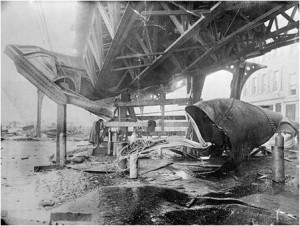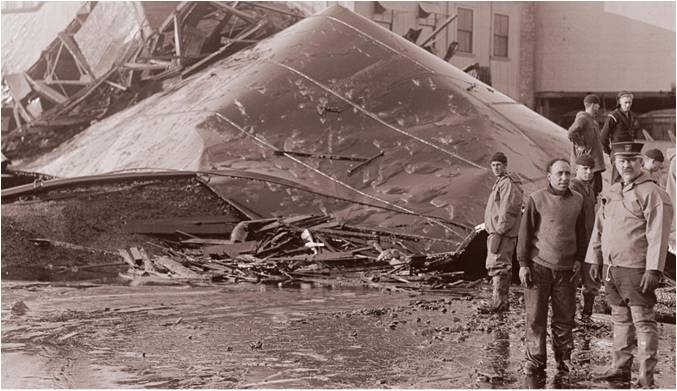Today is the anniversary of the Great Molasses Flood. Many people have written about this disaster over the years, particularly Stephen Puleo in his well-researched and highly readable book “Dark Tide.” I won’t go over all the details of the event because it would take, well, a whole book. Instead I’ll discuss some of the lessons learned.
For those readers who have never heard of the Great Molasses Flood, it took place in Boston’s North End on January 15, 1919 when a tank holding 2.3 million gallons of molasses, used in the manufacture of munitions for World War, I collapsed. The molasses, which had been fermenting in a January thaw, rushed out in all directions—a thick, viscous wave up to 25 feet high and traveling at 35 miles per hour.
It flooded streets, pushed buildings off their foundations, destroyed elevated train tracks, and entrapped people and animals. It pulverized the entire waterfront and destroyed much of Commercial Street—at the time an area of great business activity. The molasses killed 21 people, injured 150, and caused damages of over $100 million in today’s dollars. That doesn’t count the numerous animals destroyed, including dogs, cats, and over 20 horses, many housed in a municipal stable nearby.
Five hundred men working around the clock with seawater and sand took a week to clean up the worst of the damage, pushing most of the molasses into the harbor. But the molasses lingered in cracks and crannies for years. Boston Harbor ran brown with molasses until July.
Why did this tragedy happen and what three lessons did we learn from it?
-
Location
The facts: From a purely business point of view, the tank’s location made sense. It sat between the harbor, where the molasses tankers docked, and railroad tracks so trains could carry the molasses to the United States Industrial Alcohol Company’s distillery in Cambridge.
From a human perspective, however, the North End of Boston was crowded with tenements and filled with immigrant families, many from small Italian towns. Italy had only been unified for about 50 years and the immigrants still thought in terms of family and community. They kept to themselves, not participating in Boston politics, and thus could not present a voting bloc to influence decisions about their neighborhood. Without a voice they could not protest the placement of such a dangerous facility in proximity to their homes.
The lesson: Pay attention. Get involved. Speak up. Italian residents of the North End did exactly that when they won—against all expectations—a class action suit against the USIAC. Many of them subsequently applied for citizenship so they could vote and then became active in civic government.
-
Construction
The facts: The molasses tank was built quickly in 1915 under the direction of the USIAC’s Arthur P. Jell, a finance guy with no engineering education or experience. He also wasn’t an architect and couldn’t read a blueprint. Mr. Jell did not involve engineers in the construction process at any point. He also did not test the tank according to guidelines because that process would have been too expensive and time-consuming and he needed to offload a shipment from a tanker that was coming up from the Caribbean. The City of Boston did not oversee the tank’s construction, never inspected it, and never required proof that the tank could hold its contents or withstand the pressure of that much molasses.
The lesson: Regulations save lives. When I gave a presentation on this disaster at the Bitnorth Conference last fall, a member of the audience asked whether the regulations that resulted from the flood were a good thing. I replied that, “You can have ‘job-killing regulations’ or people-killing disasters. Take your pick.”
Boston later drafted and passed regulations and mandated inspections that would prevent a similar disaster from ever taking place.
-
Materials
The facts: The molasses tank, 50 feet high and 90 feet in diameter, was made of steel plates riveted together. Recently, Ronald Mayville, a senior structural and metallurgical engineer with Simpson, Gumpertz & Heger in Waltham MA, cast more light on the cause. Mr. Mayville, analyzed the collapse using modern engineering techniques, such as finite element analysis. His results were reported this week by Peter Schworm in a Boston Globe article “Nearly a century later, structural flaw in molasses tank revealed.” Bottom line:
- The steel plates were 50 percent too thin, even by 1919 standards.
- The steel was too brittle, lacking enough manganese, which made it more likely to crack.
- A 20-inch manhole was not reinforced to reduce stress.
The lesson:
This one is more difficult. The techniques Mr. Mayville used were not available in 1919 and the steel was thought to be of sufficient thickness and strength. It’s the same steel, in fact, that was used for the hull of HMS Titanic. Still, it’s best to use experts to get the work done. Had Mr. Jell hired engineers to design and build the tank he might have had a better result. Had he tested the tank properly, he would have seen the leaks. Had he listened to the site foreman, who complained for years about the tank leaking, he might have put a real solution in place instead of just painting the walls brown.
Disasters happen, sometimes in spite of the best intentions, sufficient regulations, and adequate preparations. What we can all do to prevent them is to learn from experience, listen to the experts, pay attention to details and speak up when we spot a problem. Today’s anniversary of the Great Molasses Flood is a good day to remember those lessons.
Additional Information:
- Dark Tide by Stephen Puleo
- “Nearly a century later, structural flaw in molasses tank revealed” by Peter Schworm, The Boston Globe
- “Magazine looks at science behind 1919 disaster,” by Colin A. Young, The Boston Globe
- “The Science of the Great Molasses Flood,” by Ferris Jabr, Scientific American
- Boston’s Great Molasses Flood” the Travel Channel




The Great Molasses Flood sounds like the name of a B-grade horror movie!
Graham: If the people in it had ever seen B-grade horror movie they might have agreed with you. Molasses is a viscous substance that acts like quicksand. You can’t pull yourself out of it and you can’t swim in it. 22 people died of drowning, suffocation, and being crushed by buildings that fell around them.